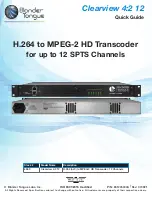
Installation and Setup
28
Hardware Reference Manual – DXLink™ Twisted Pair 4K Transmitters/Receivers
DXLink Transmitter and Receiver Ground Wire Attachment
Attaching ground wires to DXLink Transmitters and Receivers is only required when instructed to do so by Technical Support or an
electrical technician. For instructions on attaching a ground wire, see page 87.
Important Twisted Pair Cabling Requirements and Recommendations
The following requirements and recommendations apply to cabling DXLink (RJ-45) connectors:
DXLink cable runs require shielded category cable (STP) of Cat6a or Cat7.
DXLink twisted pair cable runs for DXLink equipment shall only be run within a common building.*
DXLink delivers 10.2 Gb/s throughput over shielded category cable. Based on this bandwidth requirement, we recommend
following industry standard practices designed for 10 Gigabit Ethernet when designing and installing the cable
infrastructure.
The cables should be no longer than necessary to reach the end-points. We recommend terminating the cable to the actual
distance required rather than leaving any excess cable in a service loop.
For complete cable specifications, see page 17.
NOTE:
DXLink Twisted Pair 4K cable runs include support for up to two (2) patch cables of up to 5 meters in length each, provided that
the total end-to-end cable length does not exceed 80 meters and all cables and couplers/patch panels used in the run meet the
minimum cable requirements (e.g., from DX-TX-DWP-4K to 5m patch cable, 70m cable run, 5m patch cable to DX-RX-4K using
shielded Cat6A or better for each cable length).
For more details and helpful cabling information, reference the white paper titled “Cabling for Success with DXLink” available at
www.amx.com or contact your AMX representative.
* “Common building” is defined as: Where the walls of the structure(s) are physically connected and the structure(s) share a single
ground reference.
Twisted Pair Cable Pinouts
The pinout in FIG. 14 is for twisted pair cable that connects to the ICS LAN 10/100 connector (on modules only) or to the DXLink
connector
on all Transmitters and Receivers. Use either the T568A or T568B pinout specification for termination of the twisted pair
cable used between the units in a standalone setup or between Transmitters and Receivers and an enclosure in a full system
.
In a typical installation, the cables should be stretched to their full length between Transmitters and Receivers and the enclosure or
between units in a standalone system. Service loops or coils of the cable may reduce the overall cable performance and should be
minimized whenever possible.
RJ-45 LEDs
ICS LAN 10/100 Connector LEDs (DXLink Modules only)
The following information applies to the LEDs on the ICS LAN 10/100 connector on DXLink modules (FIG. 15). Note that #1 Toggle
must
be set to ON or ICS LAN functionality will not be provided.
FIG. 14
Twisted pair cable pinouts for Ethernet connectors
FIG. 15
Module ICS LAN 10/100 connector LEDs
RJ-45 Connector LEDs
Yellow LED
Green LED
ICS LAN 10/100 LEDs
(Modules only)
Link/Activity (L/A) Green LED:
On – Link status is active (when the Ethernet
cable is connected and terminated correctly)
Off – Link status is not active
Speed Status (SPD) Yellow LED:
On – Speed status is 100 Mbps
Off – Speed status is 10 Mbps
















































